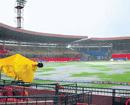 Bangalore, Feb 16: A minor fire broke out this morning at Chinnaswamy stadium where the Indian cricket team began their three-day training camp ahead of their Test series against Australia but the incident did not disrupt the practice session of Mahendra Singh Dhoni and his men.
Bangalore, Feb 16: A minor fire broke out this morning at Chinnaswamy stadium where the Indian cricket team began their three-day training camp ahead of their Test series against Australia but the incident did not disrupt the practice session of Mahendra Singh Dhoni and his men.
The fire broke out at the Members Stand when a white cloth placed as a temporary sightscreen caught fire as a consequence of routine maintenance work which involved a bit of welding, Karnataka State Cricket Academy Secretary Javagal Srinath said in a statement.
Srinath, a former India pacer, said in less than a couple of minutes, the in-house fire safety equipment was used to douse the fire and bring the situation under control.
The Indian players were undergoing their practice session at the ground at that time in preparation of their Test series against Australia beginning in Chennai from February 22.
"Practice wasn't affected in any way with a new sight screen deployed immediately afterwards," Srinath said.






Comments
Add new comment